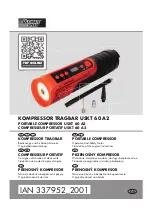
- 10 -
4 Close the compressor air outlet valve before
connecting or disconnecting a hose. Ascertain
that a hose is fully depressurized before
disconnecting it. Before blowing compressed air
through a hose or air line, ensure that the open end
is held securely, so that it cannot whip and cause
injury.
5 The air line end connected to the outlet valve
must be safeguarded with a safety cable, attached
next to the valve.
6 No external force may be exerted on the air outlet
valves, e.g. by pulling on hoses or by installing
auxiliary equipment directly to a valve, e.g. a
water separator, a lubricator, etc. Do not step on
the air outlet valves.
7 Never move a unit when external lines or hoses
are connected to the outlet valves, to avoid
damage to valves, manifold and hoses.
8 Do not use compressed air from any type of
compressor, without taking extra measures, for
breathing purposes as this may result in injury or
death. For breathing air quality, the compressed
air must be adequately purified according to local
legislation and standards. Breathing air must
always be supplied at stable, suitable pressure.
9 Distribution pipework and air hoses must be of
correct diameter and suitable for the working
pressure. Never use frayed, damaged or
deteriorated hoses. Replace hoses and flexibles
before the lifetime expires. Use only the correct
type and size of hose end fittings and connections.
10 If the compressor is to be used for sand-blasting
or will be connected to a common compressed-air
system, fit an appropriate non-return valve (check
valve) between compressor outlet and the
connected sand-blasting or compressed-air
system. Observe the right mounting position/
direction.
11 Before removing the oil filler plug, ensure that the
pressure is released by opening an air outlet
valve.
12 Never remove a filler cap of the cooling water
system of a hot engine. Wait until the engine has
sufficiently cooled down.
13 Never refill fuel while the unit is running, unless
otherwise stated in the Instruction Book. Keep
fuel away from hot parts such as air outlet pipes
or the engine exhaust. Do not smoke when
fuelling. When fuelling from an automatic pump,
an earthing cable should be connected to the unit
to discharge static electricity. Never spill nor
leave oil, fuel, coolant or cleansing agent in or
around the unit.
14 All doors shall be shut during operation so as not
to disturb the cooling air flow inside the
bodywork and/or render the silencing less
effective. A door should be kept open for a short
period only e.g. for inspection or adjustment.
15 Periodically carry out maintenance works
according to the maintenance schedule.
16 Stationary housing guards are provided on all
rotating or reciprocating parts not otherwise
protected and which may be hazardous to
personnel. Machinery shall never be put into
operation, when such guards have been removed,
before the guards are securely reinstalled.
17 Noise, even at reasonable levels, can cause
irritation and disturbance which, over a long
period of time, may cause severe injuries to the
nervous system of human beings. When the sound
pressure level, at any point where personnel
normally has to attend, is:
- below 70 dB(A): no action needs to be taken,
- above 70 dB(A): noise-protective devices
should be provided for people continuously
being present in the room,
- below 85 dB(A): no action needs to be taken
for occasional visitors staying a limited time
only,
- above 85 dB(A): room to be classified as a
noise-hazardous area and an obvious warning
shall be placed permanently at each entrance
to alert people entering the room, for even
relatively short times, about the need to wear
ear protectors,
- above 95 dB(A): the warning(s) at the
entrance(s) shall be completed with the
recommendation that also occasional visitors
shall wear ear protectors,
- above 105 dB(A): special ear protectors that
are adequate for this noise level and the
spectral composition of the noise shall be
provided and a special warning to that effect
shall be placed at each entrance.
18 The unit has parts, which may be accidentally
touched by personal, of which the temperature
can be in exess of 80 °C (176 °F). The insulation
or safety guard, protecting these parts shall not be
removed before the parts have cooled down to
room temperature. As it is technically not
possible to insulate all hot parts or to install safety
guards around hot parts (e.g. exhaust manifold,
exhaust turbine), the operator / service engineer
must always be aware not to touch hot parts when
opening a machine door.
19 Never operate the unit in surroundings where
there is a possibility of taking in flammable or
toxic fumes.
20 If the working process produces fumes, dust or
vibration hazards, etc., take the necessary steps to
eliminate the risk of personal injury.
21 When using compressed air or inert gas to clean
down equipment, do so with caution and use the
appropriate protection, at least safety glasses, for
Содержание DU-190
Страница 1: ...8 Instruction Manual English...
Страница 2: ......
Страница 16: ...16 Main Parts...
Страница 18: ...18 COMPRESSOR REGULATING SYSTEM...
Страница 22: ...22 CONTINUOUS PNEUMATIC REGULATING SYSTEM...
Страница 60: ...60 ELECTRIC SYSTEM Circuit diagram 9829 3801 10...
Страница 61: ...61 Circuit diagram 9829 3801 10...
Страница 62: ...62 ELECTRIC SYSTEM Wire harness 1094 3133 02...
Страница 65: ...65 Maintenance Log Compressor Customer Serial number Service hours Maintenance action Date By initials...
Страница 67: ......
Страница 68: ......











































